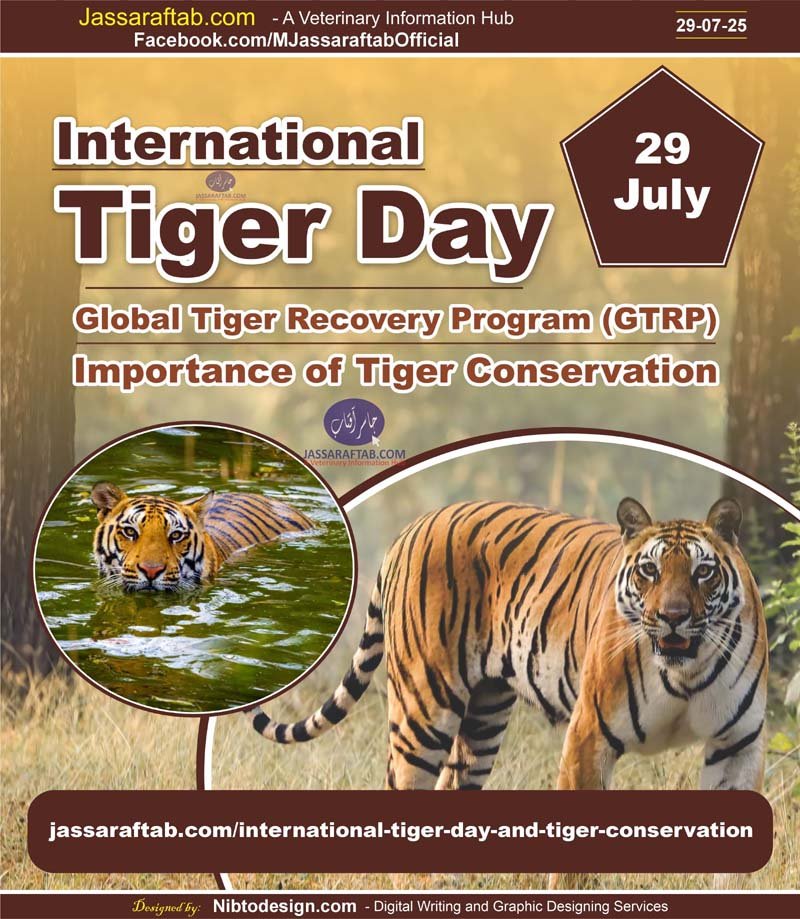
International Tiger Day | Global Tiger Day | History of International Tiger Day | Importance of Tigers | Tiger Conservation | Endangered Species | Global Tiger Recovery Program (GTRP)
International Tiger Day is celebrated on July 29th every Year. It aims to raise awareness about Tiger Conservation. International Tiger Day, also known as Global Tiger Day, serves as a powerful reminder of the urgent need to save tigers. Global Tiger Day also highlights the ecological importance of tigers and calls for global action to save the endangered species big cat. GTRP has an important role in tiger conservation.
The day was created in St. Petersburg, Russia, at the Tiger Summit in 2010. During this summit, the Global Tiger Recovery Program (GTRP) launched to double the number of wild tigers.
History of International Tiger Day
International Tiger Day or Global Tiger Day began in 2010. That year, leaders from 13 tiger-range countries met in St. Petersburg, Russia, at the Tiger Summit. However, these countries include Bangladesh, Bhutan, Cambodia, China, India, Indonesia, Laos, Malaysia, Myanmar, Nepal, Russia, Thailand, and Vietnam. They launched the Global Tiger Recovery Program (GTRP). They launched the TX2 goal, which aims to double the number of wild tigers by the year 2022. Since then, July 29 has been marked annually as International Tiger Day to track progress and renew commitment to tiger conservation.
During the summit, countries pledged to protect tiger habitats, fight poaching and illegal wildlife trade, and raise public awareness about Tiger conservation.
International Tiger Day / ٹائیگر کا عالمی دن — ٹائیگر کی خصوصیات، مسکن اور تحفظ کیلئے اقدامات
However, conservationists still face major challenges. Poaching, habitat destruction, and human-wildlife conflict continue to threaten tiger survival. Therefore, the world must continue united efforts to ensure a future where tigers thrive in the wild.
Global Tiger Recovery Program (GTRP)
The Global Tiger Recovery Program (GTRP) is an international effort to save wild tigers from extinction. World leaders launched it in 2010 during the St. Petersburg Tiger Summit. At that time, tiger numbers had fallen sharply due to poaching and habitat loss. Therefore, 13 tiger-range countries agreed on a bold goal: to double the number of wild tigers by 2022, known as the TX2 Goal.
They created national action plans, improved law enforcement, and invested in tiger habitats. As a result, countries like India, Nepal, Bhutan, and Russia showed positive growth in tiger populations. Moreover, the GTRP encouraged global cooperation, public awareness, and stronger conservation policies. Today, GTRP 2.0 continues this mission with new strategies and broader goals for 2023–2034. Ultimately, this program remains a vital step toward protecting one of the planet’s most iconic and endangered species.
World Wildlife Day – جنگلی حیات کا عالمی دن ، تھیم اور اسکی تاریخ
Purpose of International Tiger Day or Global Tiger Day
The main purpose of International Tiger Day is to raise awareness about importance of tigers. It encourages people, governments, and organizations to protect tiger habitats. It also highlights the threats tigers face, such as poaching, habitat loss, and illegal trade. Moreover, it promotes stronger conservation laws and public support.
Over the past century, wild tigers have vanished from more than 90% of their historical range. Rampant poaching, widespread habitat destruction, and growing human-wildlife conflict have pushed this majestic predator to the brink of extinction. As a result, the number of wild tigers dropped from over 100,000 in the early 1900s to fewer than 4,000 today. This sharp decline led to the establishment of International Tiger Day in 2010 at the Saint Petersburg Tiger Summit, to double the number of wild tigers by 2022.
The purpose of this day goes beyond symbolic observance. It encourages stronger Conservation Policies. It urgs governments to create and enforce laws that protect tiger habitats and tackle wildlife crime. This includes cracking down on illegal poaching and trade of tiger parts.
Moreover, the day serves as a platform to educate people, especially in tiger-range areas, about the ecological role of tigers. As apex predators, tigers help maintain healthy ecosystems by controlling prey populations.
In addition, it calls for cooperation among countries, NGOs, scientists, and local communities to share knowledge, data, and resources for tiger conservation.
International Tiger Day also highlights the progress made in tiger recovery. Furthermore, countries like India, Nepal, Bhutan, and Russia have reported positive results due to focused conservation efforts.
Importance of Tigers and Tiger Conservation
Tiger conservation is crucial for both ecological balance and biodiversity protection. As apex predators, tigers play a key role in maintaining healthy ecosystems. They regulate prey populations like deer and wild boar, which helps prevent overgrazing. As a result, forests stay balanced, supporting countless plant and animal species. Therefore, protecting tigers helps preserve entire ecosystems.
Moreover, tigers live in some of the world’s most biodiverse regions. When we protect tiger habitats, we also conserve vital forests, rivers, and carbon-rich landscapes. These forests help fight climate change, provide clean air, and support freshwater sources for millions of people.
Tiger conservation also supports local economies. In many countries, tigers attract eco-tourism, creating jobs and generating income for communities. At the same time, conservation projects often involve local people, encouraging sustainable practices and building awareness.
However, the survival of tigers is under threat due to poaching, habitat destruction, and human conflict. Without urgent efforts, we risk losing not just a species, but also the environmental and economic benefits they provide.
In conclusion, conserving tigers protects nature, supports livelihoods, and ensures a healthier planet for future generations.
Organizations Working for Tiger Conservation
Several global and national organizations actively work to protect tigers. World Wildlife Fund (WWF) leads major conservation projects across Asia. It supports anti-poaching efforts, habitat protection, and community education. Meanwhile, Wildlife Conservation Society (WCS) operates in key tiger range countries. It trains rangers, supports law enforcement, and uses technology to track tiger populations. In addition, Panthera, a global wild cat conservation group, runs the Tigers Forever program. This initiative aims to increase tiger numbers by at least 50% in core areas.
Similarly, Tiger World is also working to promote awareness about the Endangered and Threatened Species of the world.
Moreover, the Global Tiger Forum (GTF) provides a platform for 13 tiger range countries to collaborate and share best practices. Governments also play a crucial role. For example, India’s National Tiger Conservation Authority (NTCA) manages dozens of tiger reserves and conducts regular tiger census operations. Together, these organizations build strong networks to save tigers from extinction. However, they still need global support to continue this vital mission.
Tigers in Pakistan
Historically, tigers roamed parts of Pakistan, particularly in the riverine forests of Sindh and along the Indus River. However, due to habitat loss, hunting, and lack of protection, tigers became extinct in Pakistan in the early 20th century. Today, no wild tiger populations exist in the country.
Although Pakistan currently has no native wild tigers, the Lahore Zoo and Safari Park house tigers in captivity. These tigers are not part of any national breeding or reintroduction program. Pakistan also does not have an official government project dedicated to tiger conservation, as it is no longer a tiger-range country.
However, Pakistan is part of regional and global dialogues about wildlife conservation and biodiversity protection. Indirectly, efforts to conserve forests, wetlands, and riverine habitats help create awareness about endangered species, including tigers. Moreover, through participation in CITES (Convention on International Trade in Endangered Species) and other international agreements, Pakistan supports global anti-poaching and wildlife protection goals.







15 Comments
Hello. excellent job. I did not anticipate this. This is a impressive story. Thanks!
I’m still learning from you, as I’m improving myself. I certainly enjoy reading everything that is written on your site.Keep the information coming. I loved it!
Với giao diện mượt mà và ưu đãi hấp dẫn, MM88 là lựa chọn lý tưởng cho các tín đồ giải trí trực tuyến.
You can certainly see your skills in the work you write. The world hopes for more passionate writers like you who aren’t afraid to say how they believe. Always follow your heart.
采用高效谷歌站群策略,快速提升网站在搜索引擎中的可见性与权重。谷歌站群
kuwin sở hữu kho game đa dạng từ slot đến trò chơi bài đổi thưởng, mang đến cho bạn những giây phút giải trí tuyệt vời.
I got what you intend, thankyou for putting up.Woh I am thankful to find this website through google. “I would rather be a coward than brave because people hurt you when you are brave.” by E. M. Forster.
搭载智能站群程序,自动化搭建与管理,为SEO项目提供核心驱动力。站群程序
I have been surfing online more than three hours lately, but I by no means discovered any fascinating article like yours. It¦s pretty price enough for me. In my opinion, if all site owners and bloggers made excellent content as you probably did, the internet will likely be much more helpful than ever before.
Thanks a bunch for sharing this with all of us you really know what you are talking about! Bookmarked. Kindly also visit my website =). We could have a link exchange contract between us!
As a Newbie, I am always browsing online for articles that can benefit me. Thank you
I like this website very much so much wonderful info .
Thanks for sharing superb informations. Your site is very cool. I am impressed by the details that you have on this web site. It reveals how nicely you perceive this subject. Bookmarked this web page, will come back for extra articles. You, my pal, ROCK! I found just the info I already searched everywhere and just could not come across. What an ideal website.
Tham gia cộng đồng game thủ tại Go88 để trải nghiệm các trò chơi bài, poker phổ biến nhất hiện nay.
Pretty nice post. I just stumbled upon your weblog and wanted to say that I’ve really enjoyed browsing your blog posts. In any case I’ll be subscribing to your rss feed and I hope you write again very soon!